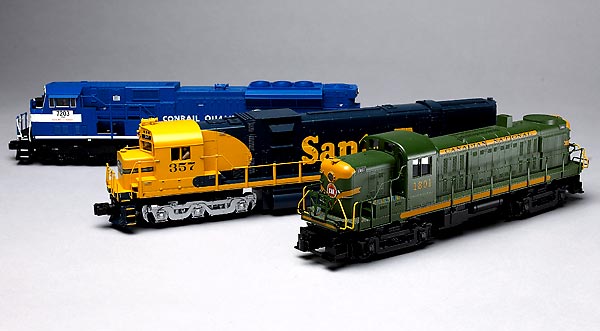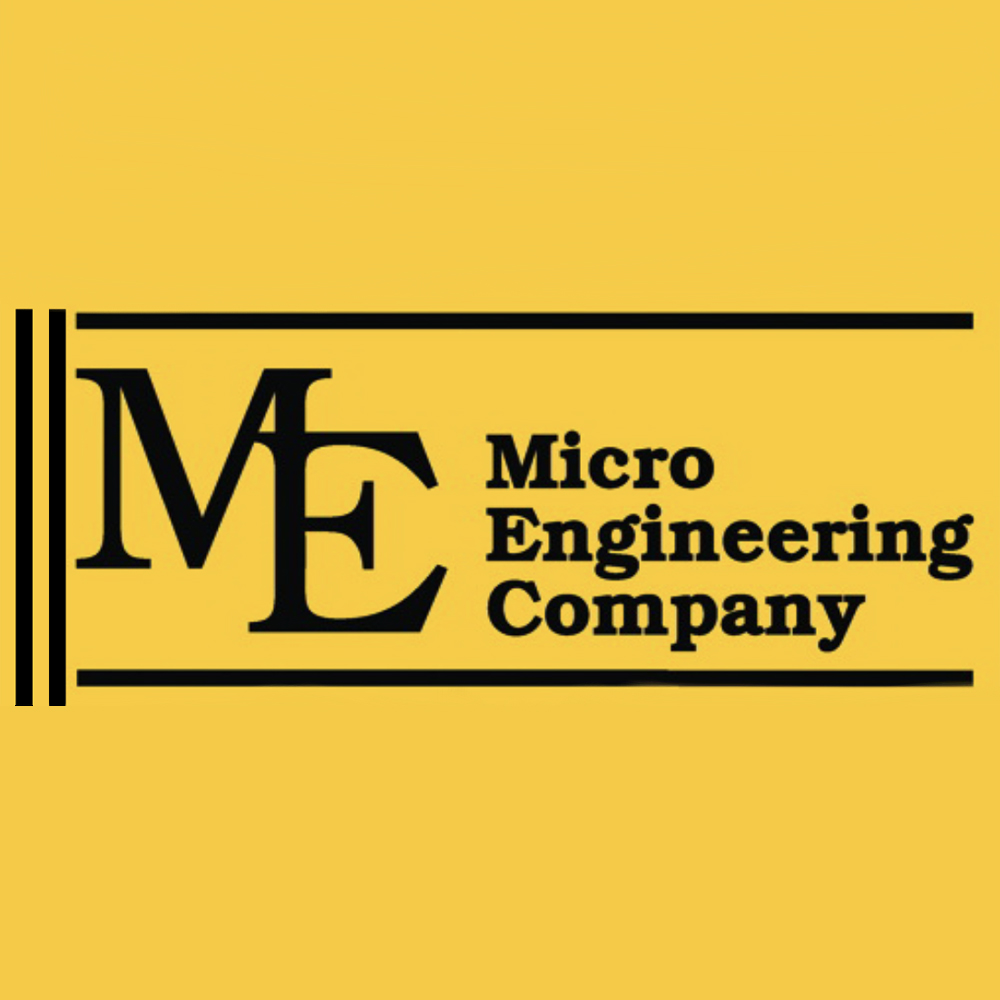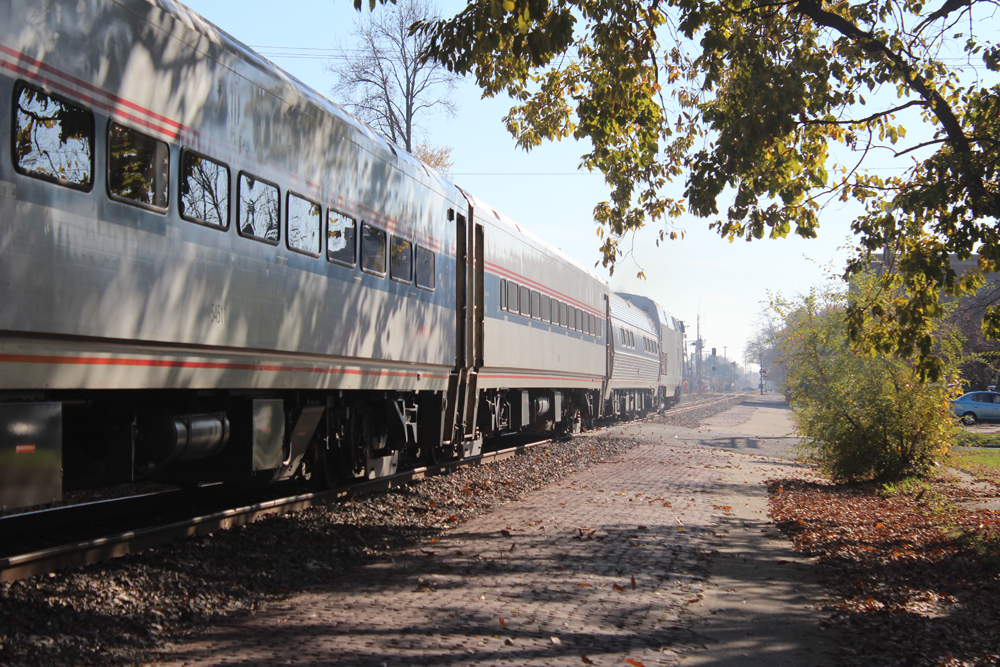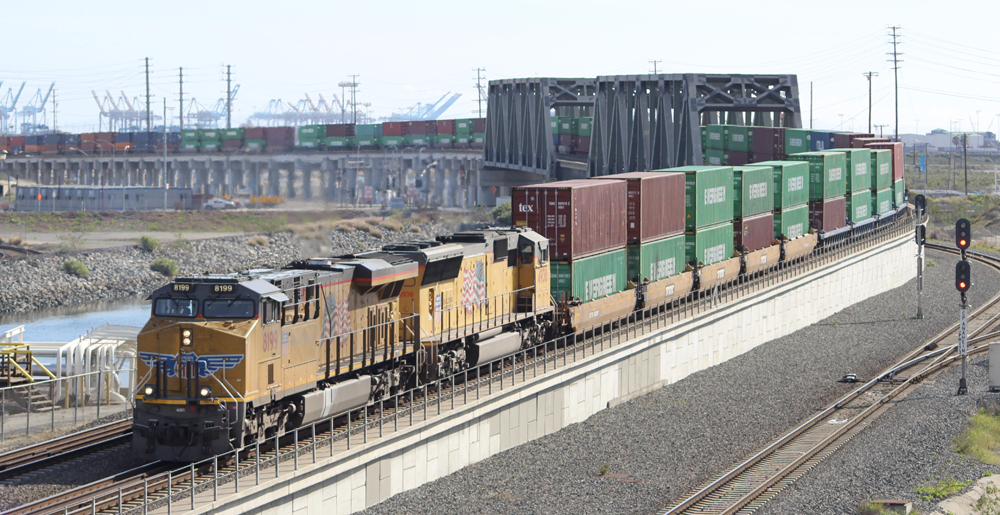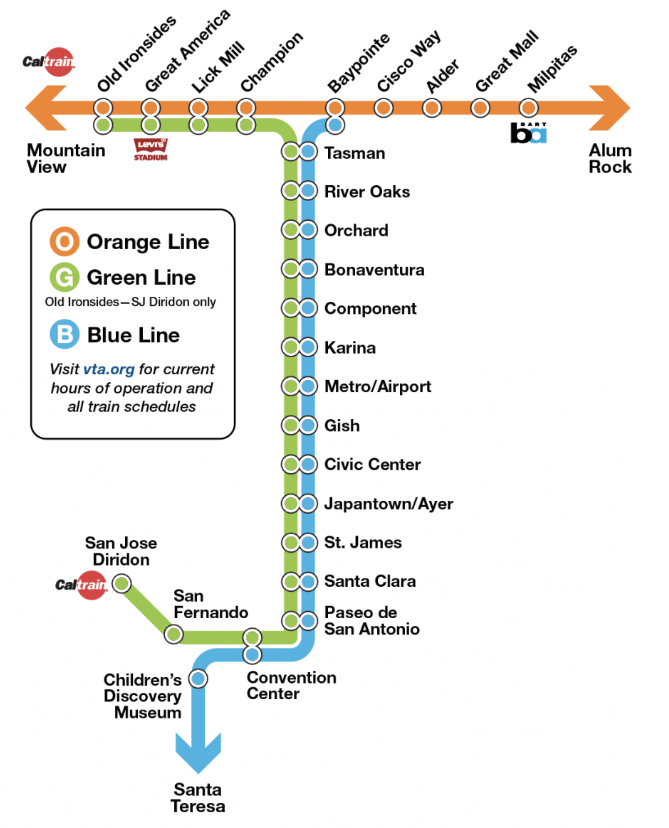The first of our trio is Weaver Models’ scale-sized Alco RS-3. This locomotive sets you up to re-create the steam-to-diesel transition years (1940-55) on your layout. As an O gauge model, this RS-3 has been around (with different drive-train designs) since the 1980s.
The second locomotive is a scale-sized MTH RailKing model of the Alco C-628, which places you squarely in the realm of second-generation diesel locomotives of the 1960s and ’70s. Weaver originally owned the tooling for this O gauge locomotive; it came into MTH’s hands in the 1990s. Beneath the shell is MTH’s ProtoSound 2.0 control and sound system.
Third is the Lionel LionMaster EMD SD80MAC, which reflects present-day railroading and changes in locomotive design and technology. As a model, it also reflects the current state of the art in mid-priced O gauge locomotives.
Weaver Models Alco RS-3
Once, a long time ago, the Alco plant in Schenectady, N.Y., was cranking out RS-3 diesels like hotcakes. More than 1,300 of the 1,600-horsepower locomotives were made for North American railroads. These locomotives readily filled a gap in a market served by legions of cab units, and they helped convince more than one railroad to speed up its dieselization program. The locomotives were rugged, reliable, and well liked.
However, like the firm that made them, the reign of the RS-3s was not permanent. These Alco switchers were eventually bumped by EMD Geeps and General Electric U-boats.
Today, there are at least 36 RS-3s in North America, a few of which still operate in revenue service.
Weaver Models first offered its Alco RS-3 as a two-rail, O scale model. As company founder Bob Weaver noted in a 1992 interview, when a distributor asked him what it would cost to convert the model to three-rail operation, he replied, “About $25,000.” The distributor told Weaver to “make the changes and I’ll buy 100 of each road name you produce.” And, as they say, the rest is history.
This O gauge RS-3 didn’t stay static in a changing world. Weaver Models later upgraded the locomotive’s drive train to include two vertically mounted can-style motors and ultimately Lionel’s TrainMaster Command Control and RailSounds systems. And, while the model railroad world moved production to Asia, Weaver continues to manufacture its RS-3 in the firm’s Northumberland, Pa., plant.
The Weaver model is, of course, a scale model, measuring 52 scale-feet long (13 inches), which matches the prototype’s 52-foot length.
The plastic body shell is filled with cast-in details, including at least 40 door hinges on each side and numerous vents, handles, rivet lines, and louvers.
I compared the shell against photos of prototype RS-3s and several diagrams and found that the model matched well with the “real thing.” I was especially impressed with the deep screen casting on the long hood. You may find yourself peering closer, attempting to see a motor inside the shell.
You’ll also find safety tread on the deck and painted wire handrails along the body and on the pilots. The locomotive trucks are die-cast metal and are nice duplicates of the prototype.
Painting and decoration are first rate. There was some office discussion about whether or not the green should have been a slightly darker shade on our Canadian National sample locomotive, but its color works for me. Of special note is the Canadian National’s “CNR” with maple leaf logo on either end.
If there is a downside to the appearance of the Alco model, it’s the top of one of the can motors showing just inside the cab windows. Most O gauge diesels today have plastic shields around this part of the motor to reduce its visual impact.
On the test track
Our sample locomotive includes Lionel’s TrainMaster Command Control and RailSounds systems. No speed-control system is offered.
The locomotive scored a low-speed average of 15.8 scale mph in conventional-control mode and a high-speed average of 127.2 scale mph. In command-control mode, the low-speed average dropped to 13.3 scale mph.
Drawbar pull for the 4 pound diesel locomotive was 2 pounds.
Out of the box our sample locomotive needed a few adjustments. The truck on the short-hood end of the RS-3 snagged on a part of the frame, causing it to derail when running short-hood forward. We fixed the problem by removing the shell and popping the truck into position.
The second problem was a rubbing noise. It turned out that on our sample the flywheel on the motor beneath the long hood of the locomotive was lightly rubbing the inside of the shell, enough to leave a small mark.
Beyond that, the RS-3 performed as expected. All TMCC functions worked properly, and the sound system was that of a robust yet typically rough idling Alco diesel, which is a nice change of tune from the normal EMD sounds.
Weaver’s RS-3 is no spring pup, but it continues to chug along, much like the prototype locomotive it’s modeled after.
MTH RailKing Alco C-628
There I was, standing on the Penn Central main line in Hamilton, Ohio, holding my uncle’s 35mm camera. The grade-crossing equipment began to chime, the gates lowered, and around the corner roared a northbound Penn Central freight train, led by Alco C-628 no. 6300. The train had to be going like 90 mph. Well, okay, this was the Penn Central, so it was really going like 40 mph.
Whew. Big time excitement! And since then, the larger, later Alcos like the C-628 and C-630 have always had a special place in my heart.
Alco built only 181 C-628s for North American railroads between 1965 and 1968. The six-axle giants mustered 2,750 horsepower and could be equipped with steam generators for passenger service at speeds up to 80 mph.
Like many later Alcos, however, the C-628s weren’t quite what the market needed. Their short lifespan was due primarily to their minority-builder status, rather than any intrinsic design flaws.
Too bad, because the C-628s were darned impressive amid a sea of aging GP9s and F units. Interestingly, three C-628s still exist in railroad museums – two in Mexico, one in Australia, and none in America.
The second in our trio of mid-priced O gauge diesels is a scale-sized Alco Century 628 from the MTH RailKing line. RailKing was once the domain of locomotives that were scale more by chance than design. MTH initially offered a wide variety of locomotives condensed in size to accommodate tight turns.
These days, those early models have been bumped to MTH’s “Rugged Rails” line of starter gear, replaced with locomotives mostly scale in size, but lacking top-of-the-line details.
The RailKing C-628 is a true 1:48 model. The frame of the model is 64 feet long in O scale (161/2 inches) compared to the prototype’s 64 feet, 8 inches. But the RailKing model’s scale dimensions come with a price – it has a minimum curve diameter of O-42.
This model has an interesting history. The tooling was originally owned by Weaver Models, but was sold to MTH Electric Trains before Joe Hayter, current president of Weaver, took over.
MTH held onto the tooling while it gradually upgraded and incorporated it into the RailKing line. While most of the MTH changes are internal, it is far easier now to remove the body shell than on the earlier Weaver version. Trust me, I own one of the older Weaver models.
While the body shell has plenty of hatch, latch, and door detail cast right in, it doesn’t have the see-through screens, add-on steps, or grab irons that are relatively common today on O gauge diesels.
The tooling is basic and attractive, but nothing that will leave you gasping in astonishment. But then a scale-size diesel with top-shelf ProtoSound 2.0 electronics priced at $299 may be enough astonishment for most of us.
I know it works for me.
Paint and decoration on our sample locomotive, in a Santa Fe blue freight paint scheme, are basic yet well applied.
As with the RS-3, the only cosmetic downside is inside the cab. You see a big, honking screw on a black background.
On the test track
Our sample C-628 scored a low-speed average of 3.7 scale mph in conventional-control mode and a high-speed average of 71.6 scale mph. In MTH’s Digital Command System mode, the Alco’s low-speed average was a wee 2.6 scale mph.
Drawbar pull for the 5 pound, 7 ounce diesel locomotive was 3 pounds, 3 ounces.
Gremlins seemingly attacked our sample Alco during its evaluation. The unit ran fine the first day we had it. But the next time we started up the locomotive, it wouldn’t operate in either DCS or conventional-control modes.
So we were off to our local MTH service center. The MTH locomotive came back quickly with a verdict of “nothing wrong.” Sure enough, it worked fine. Go figure.
The MTH sound system is first rate, and the special sound features, accessible only in command-control mode, will appeal to many operators who want more pizazz in their train running. It has a throaty Alco motor sound that stands out amid a chorus of Geep audio packages.
The smoke unit is prolific, and it can generate quite a haze if left on when running the engine for more than 10 minutes.
In sum, I’ll give the Alco C-628 a “B” for looks. All the major details are there, but there aren’t any externals that make you say “wow.”
As far as I’m concerned, the biggest bang for the buck with the C-628 is in the ProtoSound 2.0 package. It offers industry-leading operation capabilities as well as terrific sound, all at a relatively bargain-basement price. If you’re ready to take the plunge into DCS, this is the model to do it with.
Lionel LionMaster SD80MAC
Lionel has added a contemporary diesel to its LionMaster line of semi-scale O gauge locomotives.
The real SD80MAC is notable for its experimentation with AC-powered traction motors. While alternating current is no stranger to O gauge hobbyists, most real-life diesel locomotives use DC-powered traction motors.
The Electro Motive SD80MAC’s were built at EMD’s factory in London, Ontario, and finished at Conrail’s famous Altoona, Pa., shops. Powered by 20-cylinder 710G3B turbocharged diesels, the high-tech locomotives feature fuel injection and self-steering trucks.
Technological improvements led to better fuel efficiency and lower emissions and even 15 percent more track adhesion than previous diesels. It is estimated that two of the 5,000-horsepower SD80MAC locomotives can replace four 3,000-horsepower diesels.
Although the SD80MAC helped establish the benefits of AC-powered locomotive traction motors, just 30 examples of the model were built, all ending up on Conrail, which has since been split up between CSX and Norfolk Southern.
Though the LionMaster product line is associated with semi-scale products, this locomotive is not some sort of shrunken-head type of diesel.
It measures 64 feet long in O scale (161/2 inches) compared to the prototype’s 76-foot length. It’s short, but you still have a large hunk of diesel power.
Unlike the Weaver RS-3 or MTH C-628, this broad-shouldered model was produced from new tooling, and it shows. Visually, there is a lot to see and touch. Why? Because the prototype is chockfull of “things” to run your finger over, and the overall design is full of jutting angles and rectangular blocks.
There are 12 louvers, vents, and screens on the fireman’s side, and eight on the engineer’s side. At the tail of the locomotive are four lights, two more screens, and two number boards. On the nose are a door, separately applied grab irons, six lights, black-on-white number boards, and six separately applied windshield wipers.
On top, you’ll find four fans, not to mention the exhaust outlet, which on this model doubles as the smoke-fluid hole. The cab houses two crew figures and a shield to hide the front can-style motor. Between its color and the placement of the cab lighting, the shield fades into the background nicely.
When Conrail was purchased and divided by CSX and Norfolk Southern, the locomotive and equipment fleet was split up. Someone with a sense of history decided that Conrail gear destined for CSX would be marked on the cab as New York Central and gear heading to Norfolk Southern would be marked for the Pennsylvania Railroad. Hence the small PRR below the overpainted “7203” on the sides of the cab of this model.
Overall, the Conrail Quality paint scheme is well executed.
On the test track
The Lionel LionMaster SD80MAC features TrainMaster Command Control, RailSounds, and Odyssey speed control.
In conventional-control mode, our sample locomotive scored a low-speed average of 31.7 scale mph, higher than expected. The high-speed average was 110.8 scale mph.
However, in command-control mode, the low-speed average dropped down to a highly respectable 4.2 scale mph.
Drawbar pull for the 6 pound, 1 ounce diesel locomotive was 2 pounds, 12 ounces.
Performance was smooth in all speed ranges. All TMCC functions and the Odyssey speed control worked as expected. The smoke unit seemed to be able to match the MTH C-628 in its ability to crank out London-style fog.
When the RailSounds system kicked in, I got goose bumps. It is a superb re-creation of the prototype that will have you wishing you could pump it through your home theater system.
It’s tough not to like the LionMaster SD80MAC. From its wide cab up front to the angled radiators at its rear, this model is, dare I say, “macho.”
Designers slightly compressed the SD80MAC to allow operation on O-31 or tighter diameter curves, but it remains well proportioned. This locomotive is a superbly decorated, solid performer. If you favor modern locomotion on your railroad, the LionMaster SD80MAC may well become your favorite.





